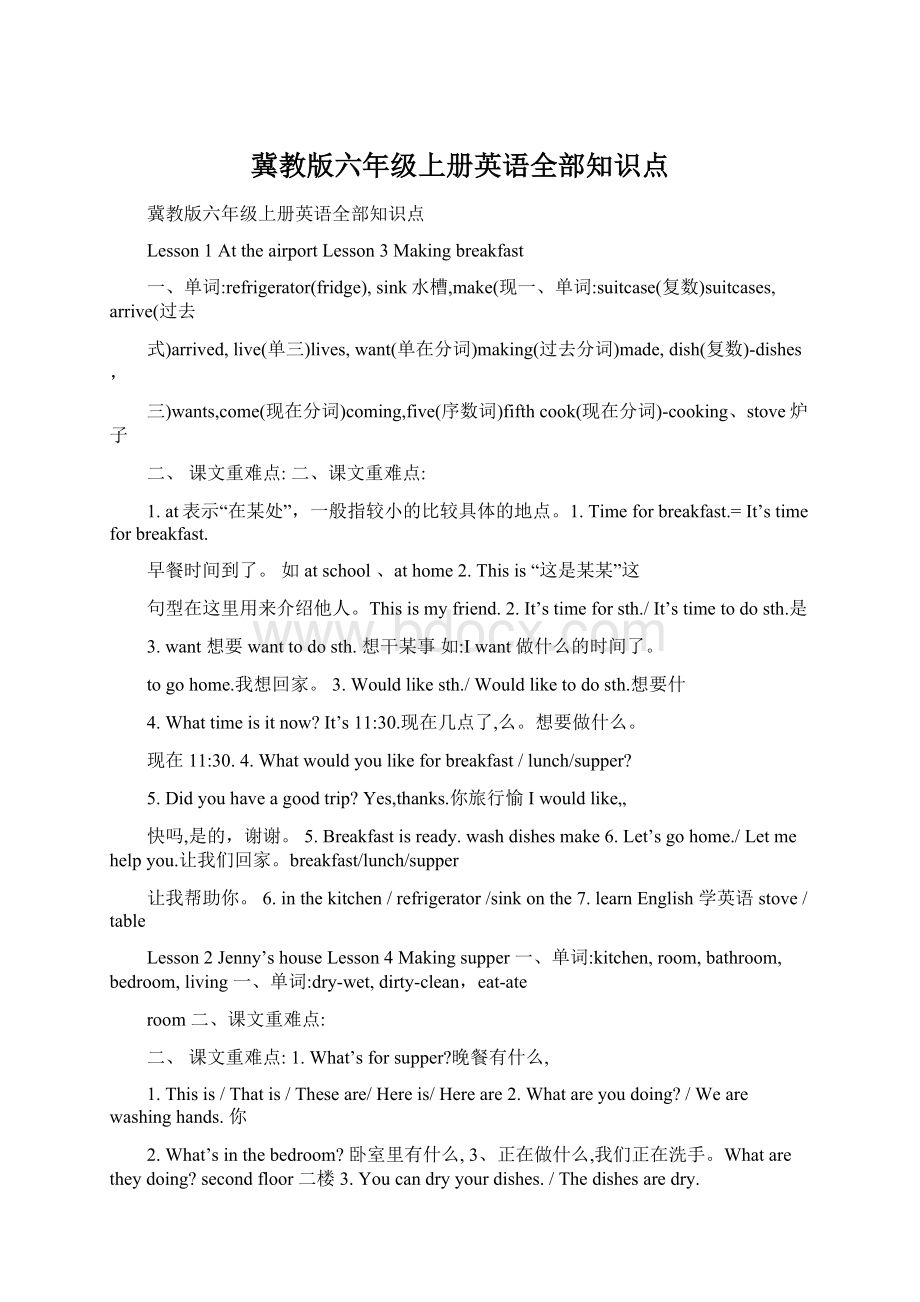冀教版六年级上册英语全部知识点文档格式.docx
《冀教版六年级上册英语全部知识点文档格式.docx》由会员分享,可在线阅读,更多相关《冀教版六年级上册英语全部知识点文档格式.docx(6页珍藏版)》请在冰豆网上搜索。

快吗,是的,谢谢。
5.Breakfastisready.washdishesmake6.Let’sgohome./Letmehelpyou.让我们回家。
breakfast/lunch/supper
让我帮助你。
6.inthekitchen/refrigerator/sinkonthe7.learnEnglish学英语stove/table
Lesson2Jenny’shouseLesson4Makingsupper一、单词:
kitchen,room,bathroom,bedroom,living一、单词:
dry-wet,dirty-clean,eat-ate
room二、课文重难点:
1.What’sforsupper?
晚餐有什么,
1.Thisis/Thatis/Theseare/Hereis/Hereare2.Whatareyoudoing?
/Wearewashinghands.你
2.What’sinthebedroom?
卧室里有什么,3、正在做什么,我们正在洗手。
Whataretheydoing?
secondfloor二楼3.Youcandryyourdishes./Thedishesaredry.
1
4.Let’swashthedishes.让我们洗盘子吧。
2.Doyouusuallygotoschoolby„?
Lesson8LiMingmeetsJenny’sclass5.MayIhelpyou?
Sure.我可以帮你吗,当然。
Lesson5Inthelivingroom一、单词:
same(反义
watch(现分)-watching,sit(现分)-sitting,词)different,subject,class,math\science\art\read(现在分词)-reading,write(现在分词)-writing,PE\music,havelunch\supper\breakfastdo(现在分词)-doing,play(现在分词)---playing,二、课文重难点:
1.Whereareyoufrom?
IamfromChina.你来自哪二、课文重难点:
1.watchTV/readthenewspaper/writealetter里,我来自中国。
2.Whatelsecanyoufindinthelivingroom?
2、whatsubjectsdoyouhaveinyourschool,wehave3.Doyoulikethisshow?
Yes,Ido/No,Idon’math...
t.3、Howmanyclassesdoyouhaveeachschoolday?
4.inthecorner.EveryoneinthelivingroomThreeclassesinthemorningandtwointheisquiet.afternoon.
Lesson7OntheschoolbusLesson9Mr.Woodteachesalesson一、单词:
always,usually,sometimes,never,bus一、单词:
temperature,shape(形状),line,circle,stop,busdriver,schoolbussquare,triangle,degree(复数)degrees,hot(反义
三、课文重难点:
词)cold,outside(反义词)inside,ill、healthy健
1.祈使句:
Don’tgothere./Don’tforgetyour康的
umbrellas.三、课文重难点:
2.频率副词用法:
一般都放在行为动词之前,助动词1.How’stheweathertoday?
It’srainy.今天天
和情态动词之后。
气怎样,多雨。
如:
Heneverwearsdresses./Ineverwalk.2.What’sthetemperature?
It’stendegrees.1.Ilivetoofarfromschool.ontheschool气温多少度,十度。
bus.
2
3.What’syourfavouriteshape?
Myfavourite一、单词:
spring,summer,fall(autumn),winter,
scarf,ice,winterclothes、leaf(复数)---leaves,shapeisacircle.
4.Howmanylinesmakeatriangle?
Three.rain(形容词)rainy,wind(形容词)windy,sun(形容
Lesson10Howmanyarethere?
词)sunny,snow(形容词)snowy,cloud(形容词)cloudy一、单词:
man(复数)---men,woman(复数)---women,三、课文重点、难点:
child(复数)---children1.Whatahot,sunnyday!
多么热、晴朗的天啊~put二、课文重点、难点:
on/takeoff
1.Thisisa„/Theseare(some/many)„Thatis2,puton表示穿的动作,wear表示“穿着”的状态。
a„/Thoseare„如:
Pleaseputonyoursweater./Hewearsared
2.Hereisa„/Hereare(some/many)„jackettoday.
3.Howmanypensarethere?
Therearetenpens。
3.Therearefourseasonsinayear.
Lesson11Alwaysdoyourhomework!
4.Iliketherain,butIdon’tliketogetwet.一、单词:
wear(同音词)where。
two(同音词)too5.Whatdoyouwearinwinter/spring/summer
二、课文重难点:
/fall?
1.Doyoualways„?
/Doesheusually„?
Lesson14Snow!
It’swinter!
2.walktoschool/helphismother/ridemybike一、写单词:
ski(现在分词)skiing,teach(对应
/doyourhomework词)learn,outside(反义词)inside,forget(过去
3.thesamequestions/bybus/takethebus式)forgot,put(现在分词)putting、skate滑冰、ski4.Let’sput„for„/Let’sput„in„滑雪
5、inCanada/onarainyday/readabook/sing二、课文重点、难点:
asong1.Novemberninth九月九日
6、Howmanytrianglesdoyousee?
2.JennyandLiMingaregettingreadyforschool.
Lesson13Seasons3.Snowisfalling.
4.Lookout(of)thewindow!
朝窗外看~
3
5.Whatdoyouliketodoinwinter?
1.askatinglesson/askiinglesson.滑冰课、
滑雪课6.Iliketoskateontheice./Iliketoskion
thesnow.2.Canyouskateforwards?
7.Canyouskate?
/Canyouteachme?
3.apairofskates./putonyourskates./put8.Iwanttogooutsidetoplayinthesnow.themon.
9.Why?
Becauseit’scoldoutside.4.Dannyiswalkingforwards/backwards.
5.turnaround10.Let’sgooutside!
/Let’sgoinside!
11.Therehecomes.吆,他来了。
/There!
瞧6.LiMingskatesbackwardsslowly.
Lesson15Winterfun7.standup/comeon/falldown一、单词:
snowman(复数)snowmen,snowball(复8.teachsbtodosth.Youlearnfast.
数)snowballs,stick(复数)sticks,rock(复Lesson17Ilikeallseasons
数)rocks,small(比较级)smaller一、会说会读会写单词:
fun,favourite
二、课文重点、难点、疑点解析:
二、课文重点、难点:
1.Doyouknowwhatasnowmanis?
1.What’syourfavourite„?
2.makeaface/makeabigballofsnow/make2.Iliketodosth.我喜欢去做某事。
snowmen/makeasnowman3.Doyouliketodosth?
你喜欢做什么,
3.put„on„/put„ontopIthinkIcan.4.Ilovespring,doyou?
我喜欢春天,你呢,
4.WhatelsedoyoudoinwinterinChina?
5.Temperaturesarecool.气温是凉爽的。
5.Ihavetwosticksforhisarms.Lesson19Christmasiscoming6.AissmallerthanB.一、单词:
Christmas,Christmastree(s),Christmas
Lesson16Askatinglessonlights,holiday,song,card(s),gift(s),Santa,一、单词:
think,teach,falldownspecial,bring(单三)brings,west(形容词)western
二、课文重点、难点:
三、课文重点、难点:
4
1.What’sChristmas?
It’saWesternholiday.3.TodayweareputtinguptheChristmastree.
4.Thatisanoldstory.圣诞节是什么,是西方的节日。
2.WhoisSanta?
Heisamerrymaninredclothes.5.Weopenourgifts.bringsbsth.take3.on/atChristmasMerryChristmas!
pictures.
4.invitesbtosomeplace.如:
WeinvitefamilyandIsitfromChina?
It’saChineselantern.friendstoourhouse.6.Iaskedmymothertosendit./asksbtodosth.
7.begoingtodosth./Whatareyougoingtodo?
5.bringsthforsb.如:
Theybringgiftsforus.
6.givesbsth.如:
WegiveourfamilyandfriendsLesson21Christmascardsgifts,too.一、单词:
today,yesterday,tomorrow,often,find,
7.singspecialsongs.Wehavefuntogether.walk(单三)--walks,(过去式)-walked,bring(单
我们在一起很愉快。
三)---brings(过去式)---brought
8.WhenisChristmas?
It’sDecembertwenty-fifth.三、课文重点、难点:
Lesson20Oh,Christmastree1.bringsthto+地点./bringsthforsth一、单词:
be(过去式)-was/were,see(过去式)-saw,2.writingChristmascards./writesthtosb.bring(过去式)-brought,know(过去式)-knew,3.Doyouwanttosendacard?
teach(过去式)-taught,grow(过去式)---grew,4.Let’sfindthecardwithSanta.putup装
put(过去式)---put,teach(名词)teacherquiet(副饰,包装
词)---quietly,quick(副词)---quickly,slow(副5.Jenny’sfamilyisgettingreadyforthe词)---slowly、loud(副词)---loudlyChristmasholiday.
二.重难点:
Christmastree圣诞树/ChristmasLesson22Christmasgifts
gifts圣诞节礼物一、单词:
something,give,shop(现在分
1.Whatwouldyoulike?
Iwouldlike„/What词)---shopping,toy(复数)---toys
wouldyouliketodo?
Iwouldliketobuyagift.三、课文重点、难点:
2.seeyousoon/later/tomorrow.1.givesbsth./givesthtosb.
5
3.Iwanttobuysomethingformyfamilyforbox-boxes,brush-brushes,watch-watches
3(以“辅音字母+y”结尾,变y为i,再加-es,如:
Christmas.
4.Whatdoyouwanttobuy?
Iwanttobuygifts.family-families,strawberry-strawberries5.WhatwouldyoulikeforChristmas?
Iwouldlike4(以“f或fe”结尾,变f或fe为v,再加-es,如:
sometoys.knife-knives
表示月份的词:
January一月February二月March二、一般现在时
1、一般现在时的构成:
1)be动词:
主语三月April四月May五月June六月July
七月August八月September九月October十月+be(am,is,are)+其它。
Iamaboy.November十一月December十二月2)行为动词:
主语+行为动词(+其它)。
Westudy表示数字的词:
first第一one一second第二English.我们学习英语。
3)情态动词:
主语+can+动two二third第三three三thirteen十三词原形+其它
thirty三十fourth第四four四fourteen十当主语为第三人称单数(he,she,it)时,要用动四forty四十fifth第五five五fifteen词的第三人称单数,主语为复数时,要用动词原型。
十五fifty五十sixth第六six六sixteen十如:
MarylikesChinese.Welikecat。
六sixty六十seventh第七seven七seventeen2、be动词否定句:
主语+be(行为动词、情态动词)十七seventy七十eighth第八eight八eighteen十+not+其它。
Heisnotaworker.八eighty八十ninth第九nine九nineteen3、be动词一般疑问句:
Be+主语+其它。
-Areyou十九ninety九十tenth第十ten十twenty二astudent?
Yes.IamNo,I'
mnot.
4.行为动词的否定句:
主语+don'
t(doesn'
t)+动十hundred百eleventh第十一eleven十一
twenty-one二十一twelfth第十二twelve十二词原形+其它。
Idon'
tlikebread.当主语为第
三人称单数时,要用doesn'
t构成否定句。
He一、名词复数规则
1(一般情况下,直接加-s,如:
book-books,bag-bags,doesn'
toftenplay.
5、行为动词的一般疑问句:
Do(Does)+主语+动词cat-cats,bed-beds
2(以s.x.sh.ch结尾,加-es,如:
bus-buses,原形+其它。
-Doyouoftenplayfootball?
-Yes,
6
Ido./No,Idon'
t.当主语为第三人称单数时,要四、将来时
1)时间词:
tomorrow,nextday(week,month,用does构成一般疑问句。
-Doesshegotowork
bybike?
-Yes,shedoes./No,shedoesn'
t.year„),soon,thedayaftertomorrow(后天)等。
特殊疑问句:
疑问词+一般疑问句。
Howdoesyour2)基本结构:
?
begoingto+do;
will+do.fathergotowork?
3)否定句在be动词(am,is,are)后加not或情态6、动词+s的变化规则:
1)一般情况下,直接加-s,动词will后加not成won’t。
4)一般疑问句be或will提到句首,some改为any,and如:
cook-cooks,milk-milks
2)以s.x.sh.ch.o结尾,加-es,如:
guess-guesses,改为or,第一二人称互换。
wash-washes,watch-watches,go-goes3)以“辅音五、过去时
字母+y”结尾,变y为i,再加-es,如:
study-studies1、时间词:
:
三、现在进行时yesterday,lastweek,threedaysago,in1998
1)现在进行时的肯定句基本结构为be+动词ing.2、构成:
主语+动词的过去时2)现在进行时的否定句在be后加not。
3、规则动词过去式的构成有四条规则:
一般在动词3)现在进行时的一般疑问句把be动词调到句首。
原形末尾直接加上-ed。
以不发音的字母e结尾的动4)现在进行时的特殊疑问的基本结构为:
疑问词+be词,去e再加-ed。
末尾只有一个辅音字母的重读闭+主语+动词ing?
音节,先双写这个辅音字母,再加-ed。
末尾是辅音但疑问词当主语时其结构为:
疑问词+be+动词ing?
字母+y结尾的动词,先变y为i,然后再加-ed。
5)动词加ing的变化规则3、否定句结构为:
主语+didnot(didn'
t)+动词原形+1(一般情况下,直接加ing,如:
cook-cooki